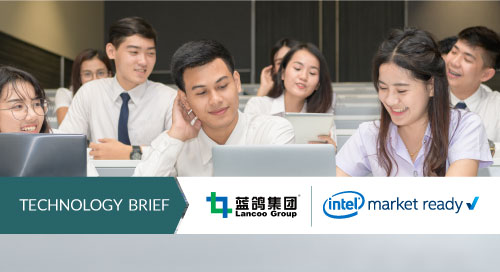Ed Tech Transforms the Smart Campus

Transformation of digital classrooms into smart campuses creates a more efficient, personalized, and productive educational environment. And as schools embrace integrated platforms for improved teaching, learning, and administration, the smart campus is becoming a reality.
In China, the central government is driving innovation as a means of accelerating modernization. AI, computer vision, IoT, and other technologies are at the forefront of research and pilot programs as educational institutions build toward digital transformation.
Though many schools in China have partially built digital systems, their effectiveness is often limited. Applications are typically isolated from one another due to lack of unified technology standards and processes. As a result, teaching quality and education management do not improve.
Ed Tech Connects Classrooms and Campuses
A smart campus is one that’s integrated—eliminating information silos and bringing together data from all sides of the educational spectrum. This means students benefit from a reliable, personalized, and engaging learning environment.
A smart campus also enables school administrators to assure that teaching equipment and software are functioning normally, and if not, to fix problems without going from site to site.
And it’s not just about administration and instruction. A smart campus can conserve energy by knowing how and where it is used. It can automatically act on information such as lights remaining on when a classroom is empty. Teaching can also be more environmentally friendly because a fully digitized teaching, learning, and administration platform can help a school go paperless.
Smart classrooms support better instruction and improved learning by giving teachers and students access to more knowledge and information. Such classrooms commonly include innovations like live streaming, video-on-demand, remote lessons, interactive learning, student performance analysis, and more.
With the help of artificial intelligence and real-time analytics, smart-campus applications become even more powerful. AI tools can help reduce teachers’ workloads and improve educational outcomes by assisting with examinations, test preparation, tutoring, lesson planning, and more.
A smart campus is one that’s integrated—eliminating information silos and bringing together data from all sides of the
educational spectrum.
Educational Technology: The Heart of the Smart Campus
The Pudong Digital Learning Center is at the vanguard of smart-campus technology in China. It started when the Shanghai Pudong New Area Education Bureau responded to the national government’s Education 2.0 Action Plan in new and innovative ways.
The bureau began moving to smart campuses by launching a pilot program in which it built digital learning centers in 15 middle and elementary schools. In doing so, it provided environments for classes that combined IT and other disciplines, as well as opportunities for foreign-language teaching labs, online testing, teacher training, and extracurricular learning for students.
The Pudong pilot program includes technology in schools as well as at the bureau’s offices. The education technology in schools included terminal teaching environments, assistive-teaching equipment, teaching applications, recording systems, digital-classroom systems, and virtual labs for science and biology.
In the administrative offices an integrated display system combined big data, visualized teaching, and learning applications. This system enabled remote class inspection, intelligent control of teaching equipment, and data sharing. Thus, the education bureau got the information it needed to analyze student performance and educational resources.
The pilot program showed that smart classrooms and campuses had three primary benefits.
- Teaching quality improved: Online classrooms let schools create a hybrid, online-offline teaching model and maximize the sharing of teaching resources.
- Learning outcomes improved: In-class interactive features and student-performance analysis made teacher-to-student and student-to-student relationships better.
- Education management improved: Intelligent equipment control and automatic diagnosis of failures made it easier to keep equipment up and running while sharing classroom resources.
The bureau and the schools that participated in its pilot program proved so adept at improving teaching, learning, and education management that local governments now look to the “Pudong Model” as an example of how modern education systems can evolve from teaching tools into teaching assistants.
Smart Hosts Power Learning
The Pudong bureau worked with Lancoo Group, a high-tech enterprise specializing in educational technology, to deploy its successful pilot program based on the company’s AI-IOT Smart Campus Solution.
Incorporating the Intel® IDV (Intelligent Desktop Virtualization) and Intel® VDD (Vision Data Device) architectures, the Lancoo Smart Host uses computer vision and AI technology based on the Intel® OpenVINO™ Toolkit to give the smart classrooms in the Pudong Digital Learning Center powerful video and data processing power. High-performance computers in each classroom ensure that different software in the classrooms can provide services, transfer and exchange information, play audio files, and perform other functions appropriately without undermining normal teaching and learning activities.
Education Technology Evolves to Meet Demands
The Pudong pilot program is just one example of a smart campus in action. Schools such as Qingdao University, Ocean University of China, and Maling Elementary School in Zhongshan City have implemented similar technology for smart classrooms and campuses.
Teaching quality, learning outcomes, and education management are improving in China as educators heed the national government’s call to overcome the limitations of disconnected education systems. Local governments will continue to apply lessons from the Pudong Model, and deployments of similar ed tech to achieve the goals of the country’s education technology strategies.
Smart solutions are turning the “Education + AI” goal into reality, transforming teaching, learning, education management, and the very form of schools themselves.